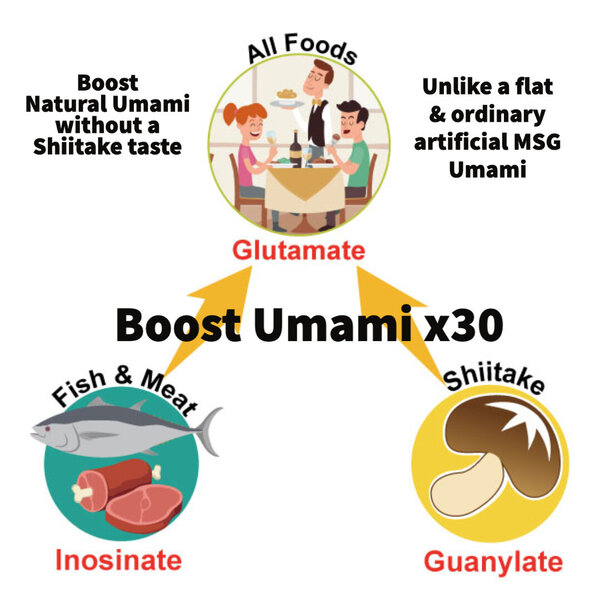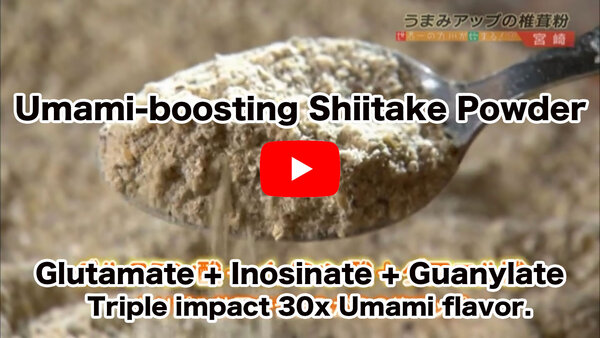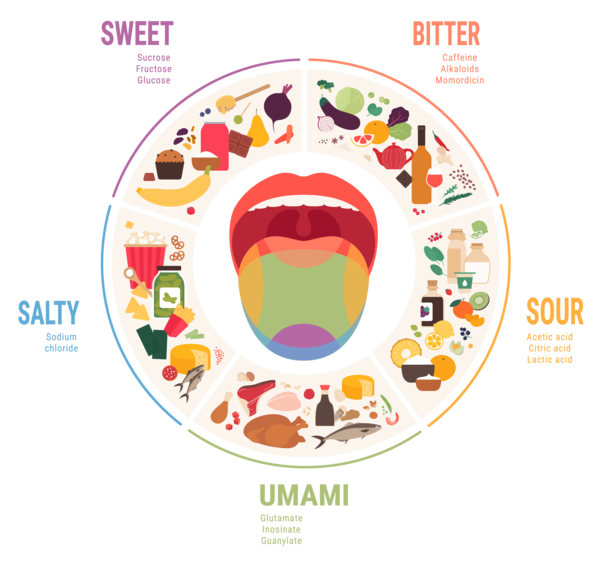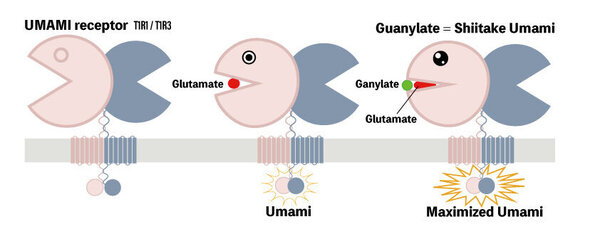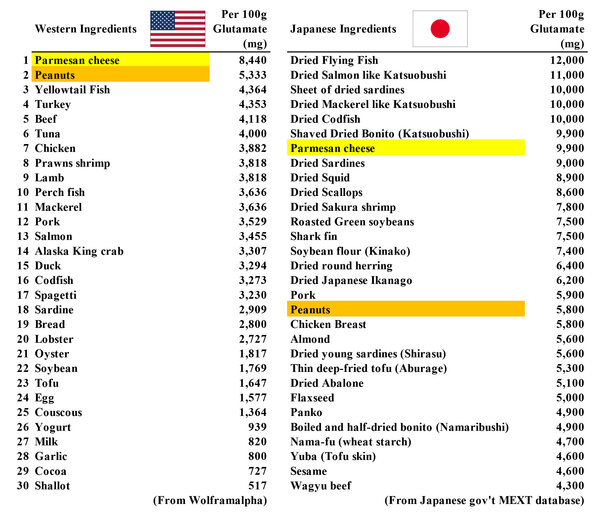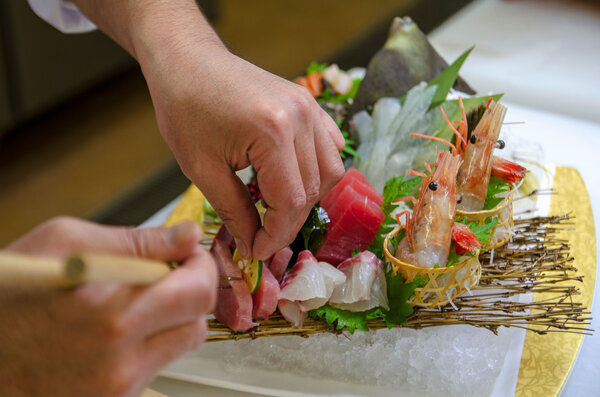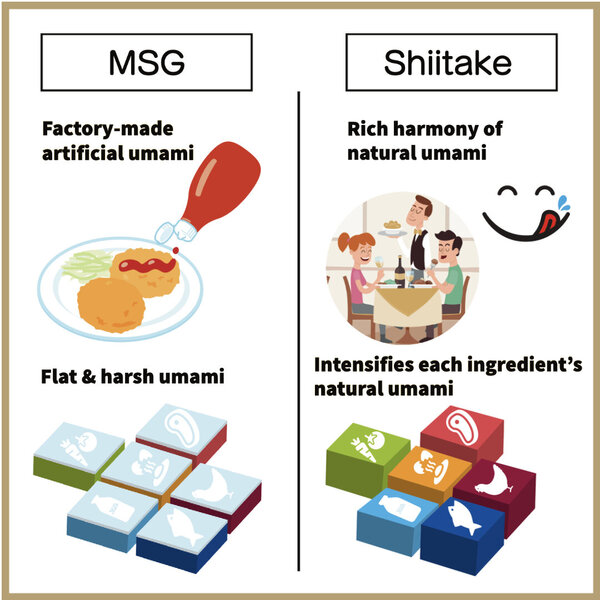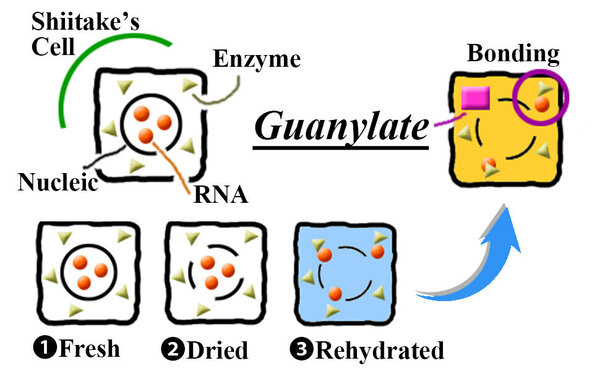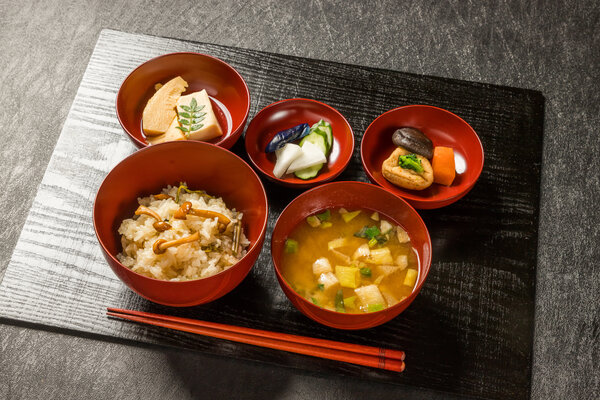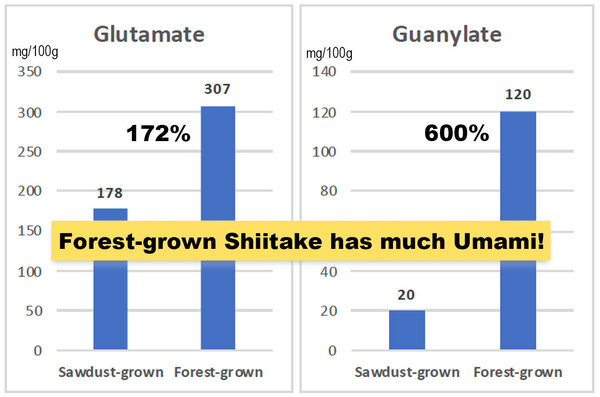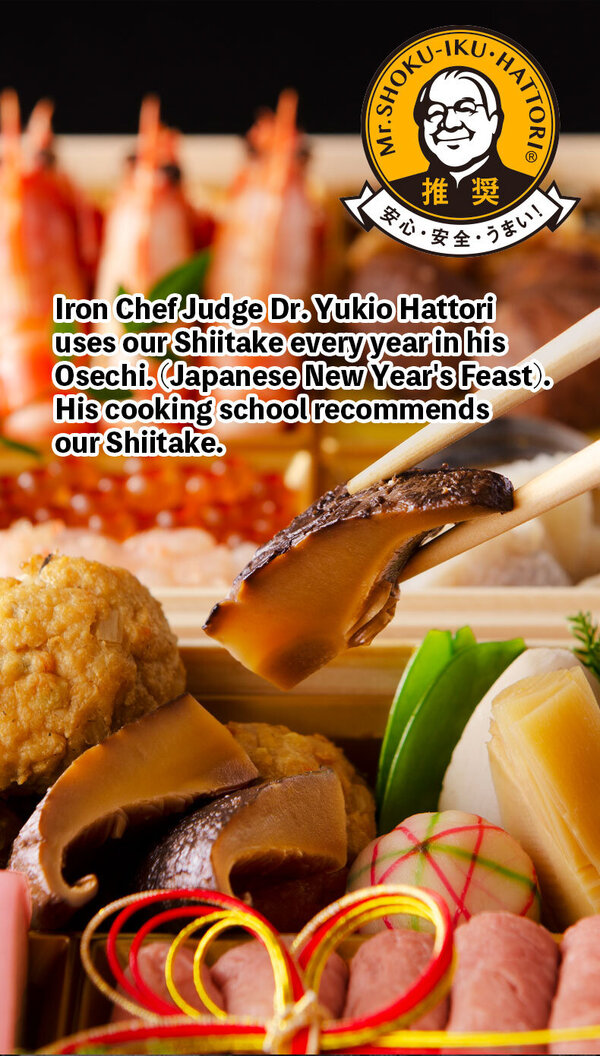- ホーム
- Dried Shiitake's 3rd Umami provides the synergy for the most delicious Umami (1. Glutamate, 2. Inosinate, 3. Guanylate)
How to rehydrate dried shiitake mushroom: Donko Koshin
Forest-grown Shiitake provides the most 3rd Umami (Guanylate) to best amp flavor.
Boosting UMAMI
A) Glutamate x Inosinate = 7x Umami
B) Glutamate x Inosinate x Guanylate = 30x Umami
The 1st umami is Glutamate. It is abundant in all foods.
The 2nd umami is Inosinate. Inosinate is abundant in meat and fish, and it is well-known that meat and fish make dishes tastier.
The 3rd umami is Guanylate, which is mainly from dried shiitake mushrooms. It is a natural umami booster that increases the umami of foods by 30 times.
However, few people are aware of the Umami Boosting power of dried shiitake mushrooms, so the effects of Guanylate are not yet well-known by most people.
Featured on TV! Umami-boosting Shiitake Powder
A Magical Powder That Enhances the Flavor of Umami. Transform the flavor of broilers into that of Free Range Chicken or lower-quality beef into that of Prime, Aged, or even Wagyu. Without adding any Shiitake taste.
What is Umami?
"Umami" is originally a Japanese word that refers to an indescribable deliciousness.
It is the fifth basic taste, after sweet, bitter, salty, and sour, resulting from compounds like glutamate, inosinate, and guanylate. This umami is what generally gives food its rich and satisfying taste.
Umami is a taste receptor to perceive proteins in foods while stimulating pleasantness and taste intensity to help humans survive better by increasing protein intake.
This taste is perceived, among other things, when an amino acid called glutamate attaches to the "umami receptors" on the tongue.
Glutamate is also the amino acid most abundant in human breast milk, which is thought to teach babies to perceive and appreciate umami taste early on.
Umami is a taste perceived in the center of the tongue, the widest part of the tongue, and it lingers on the tongue for a long time as an aftertaste.
Glutamate, the primary umami component, is found in various foods, including meat, fish, and vegetables. Meat and fish are also rich in Inosinate. However, Guanylate is found in only a few foods, the most is found in dried shiitake mushrooms.
Our Shiitake amps up the taste of all cuisines!
How does Shiitake enhance Umami?
When Glutamate enters the Umami receptors on the tongue, we feel the Umami taste. Guanylate has the effect of closing the opening of the Umami receptors so that we can feel the Umami taste intensity longer and stronger. The Umami effect provides for a more balanced taste and better overall flavor of foods (which also contributes to using less salt to make foods taste good).
Glutamate is abundant in various foods, but Guanylate is only found in a few foods, such as dried Shiitake mushrooms.
Verifying our statements: Academic Papers on Umami.
"Humans recognize the umami taste as an indicator of accessible protein in food, and the taste sensation is triggered by free amino acids, in particular by binding of the l-glutamate ion to umami taste receptors in the tongue. Glutamate (Glu) is the most abundant amino acid in human breast milk, suggesting that the newborn child is primed early for umami sensing." Read the paper
"In humans, a large synergism occurs between MSG and IMP or GMP. The maximal taste intensities of mixtures of MSG and IMP or MSG and GMP were 7 and 30 times." Read the paper
"An even more dramatic synergistic effect has been shown for MSG-GMP combinations, where a 30-fold increase in flavor intensity has been reported when equal amounts of MSG and GMP were utilized.
These data would indicate that at their optimum effectiveness MSG-GMP combinations are approximately four times more synergistically potent than MSG-IMP." Read the paper
"Combinations of soy sauce with either mycoprotein derivative, shiitake extract, or concentrated tomato extract led to maximized umami taste in the meat." Read the paper
Foods with high natural umami.
This is a ranking of Japanese and U.S. food ingredients high in Glutamate. The top U.S. ingredients, parmesan cheese, and peanuts, have similar values as measured by the Japanese government's MEXT, so a comparison between Japan and the U.S. clearly shows that Japanese ingredients are rich in umami. For clarity, we have removed highly processed and similar ingredients that duplicate each other.
Japan's top 30 umami-rich ingredients are more umami-rich than the top 5 umami-rich ingredients in the U.S.! Japan is an umami paradise, with more than six times the variety!
The uniquely Japanese umami-rich fish ingredients are often added to the broths ("dashi") of popular Japanese ramen and soba noodle restaurants, which shapes the breathtaking umami richness and wonderful flavors of the food.
When dried shiitake mushrooms (shiitake powder) are used in cooking, the synergistic effect of umami makes these glutamate-rich ingredients even more umami-rich.
The Umami-Rich Food Culture of Japan.
Why has such a unique and intense Umami food culture developed in Japan, unlike any other country? While other countries' cuisines focus on dishes centered around animal fats, Japanese cuisine revolves around Umami flavors. This is largely due to the many pro-vegan / "anti-meat prohibitions" issued historically in Japan since the Asuka period.
In 646, Emperor Kotoku,
in 675, Emperor Tenmu,
in 801, Emperor Kanmu,
in 811, Emperor Saga,
and from 1685 to 1709, "the Edict of Compassion for living creatures" was issued 135 times.
Since the Japanese historically did not openly consume meat, they instead pursued the freshness of fish and vegetables, developing techniques to enhance flavors through fermentation and drying, while gratifying our taste cravings for protein.
Therefore, unlike other countries that developed a food culture centered around meat and animal fats, Japan has fostered a culture that emphasizes unique Umami derived from fish and vegetables, pursuing the seasonal best. (Reference: "The Quest for Deliciousness(美味求真)" by Kenjiro Kinoshita)
And since the introduction of Westernization of dietary habits which was promoted as a national policy during the Meiji period, meat consumption became widespread, leading to a massive shift in Japanese cuisine!
In addition to sushi and wagyu, which are extremely popular worldwide, ramen, tonkatsu, curry, okonomiyaki, yakitori, karaage, and other izakaya's (Japanese pub) menus have dramatically evolved to become the delicious Japanese food we know today.
For the 1,225 years up until Emperor Meiji lifted the ban on meat consumption in 1871, the Japanese had been pursuing delicious Umami flavors using only fish and vegetables. When they started cooking meat with this passion for Umami, it was bound to gain enormous popularity worldwide.
Shiitake Powder's Natural UMAMI
vs.
MSG's Artificial UMAMI
The Umami in Shiitake Powder boosts the Natural Umami of each food ingredient, with or without adding a Shiitake flavor. Lab-produced MSG generally adds a simple, flat, overpowering harsh Umami taste to foods. Forest-grown Shiitake by amping up the Natural Umami of each food ingredient, creates a more elegant and balanced taste harmony.
The original Umami of each ingredient, such as in tomatoes, carrots, dairy products, meat, seafood, etc., is further intensified. Each food component becomes richer in Umami and brings out the special and unique umami flavor profile of each dish.
Dried Shiitake produces a unique Umami boosting ingredient called Guanylate, which interacts with the natural Umami or Glutamates contained in almost all foods. Our tongues have receptors that detect the 5th Taste of Umami, causing us to taste the natural Umami of Glutamate with an even deeper flavor with the presence of the Guanlyates of Dried Shiitake.
Enhancing Umami/Flavor without a mushroom taste.
Forest-grown Shiitake brings out the best tastes, not by masking or adding another flavor, and with less salt.
The rehydrated water becomes a broth/"Dashi," which can be used in many different ways to improve the flavor and Umami taste of most foods.
Please experiment by adding small amounts of this Shiitake Dashi to your cooking. Use the dashi sparingly, If the Shiitake taste is apparent and unwanted, use less.
Our 1,000-year-old Japanese natural and pure cultivation approach permits you to use the rehydrated Shiitake water as a very tasty Dashi. Rehydrating at a lower temperature will produce the most Umami taste.
(For Chinese Shiitake, due to unsanitized growing conditions and the use of chemicals and bleaches to clean the shiitake, you need to discard the first batch of rehydrated water, then squeeze water from the Shiitake, or wash with potato starch to remove the smell.)
How Shiitake Produces Guanylate
Forest-grown Dried Shiitake brings out the best natural Umami tastes, not by masking or adding another flavor, unlike dried porcini.
Shiitake's drying and rehydrating process crushes its cell membrane and produces rare Guanylate, which boosts the Umami taste of other ingredients.
Zen Cooking Traditions
Dried Shiitake concentrated sources of Umami have been the critical backbone of countless Zen dishes.
Shiitake enhances the Umami taste of non-MSG Vegan cooking(artificial MSG Umami overpowers Natural Umami flavors). Using Shiitake in Vegan cuisine makes it even more delicious!
Of course, meat lovers can also use Shiitake for cooking to enjoy the very best Umami taste.
Forest-grown vs. Sawdust-grown
Japanese Forest-grown Shiitake cost about three times as much as Chinese Sawdust-grown one. But contain twice as much Glutamate, six times as much Guanylate (not to mention safer, healthier and much more delicious).
Glutamate is the Umami of Shiitake itself.
Guanylate enhances the Umami of other ingredients.
Forest-grown Japanese dried Shiitake is healthy, sustainable, and boosts the most Umami taste of various dishes.
Recommended by renowned culinary schools
Christopher Kimball's Milk Street, a renowned culinary school in the US, recommends our Shiitake mushrooms.
Famous Japanese Chef, Dr. Yukio Hattori, uses our Shiitake for his traditional Japanese New Year Special Meal "Osechi" every year. He is known as an expert commentator on the Japanese TV show "Iron Chef."
His cooking school, Hattori Nutrition College, recommends our Shiitake and allows us to use his name on our products.
Rave Reviews
- - Vegandale Fest NY.
When our Shiitake powder is added, ice cream products such as Haagen-Dazs, which focuses on the natural Umami of non-MSG ingredients, will have an even stronger natural Umami taste.
For more details, please click on the following:
- The most delicious way to soak dried Shiitake mushrooms.
- How we produce the best Shiitake: Our Company and Harvesting Approach.
- What is UMAMI?
- Highest Vitamin D Content.
- Our Awards and Recognition.
- Vegan Recipes
- ZEN Vegan Recipes
- Other Recipes (See another 200+)
- Shiitake Powder

